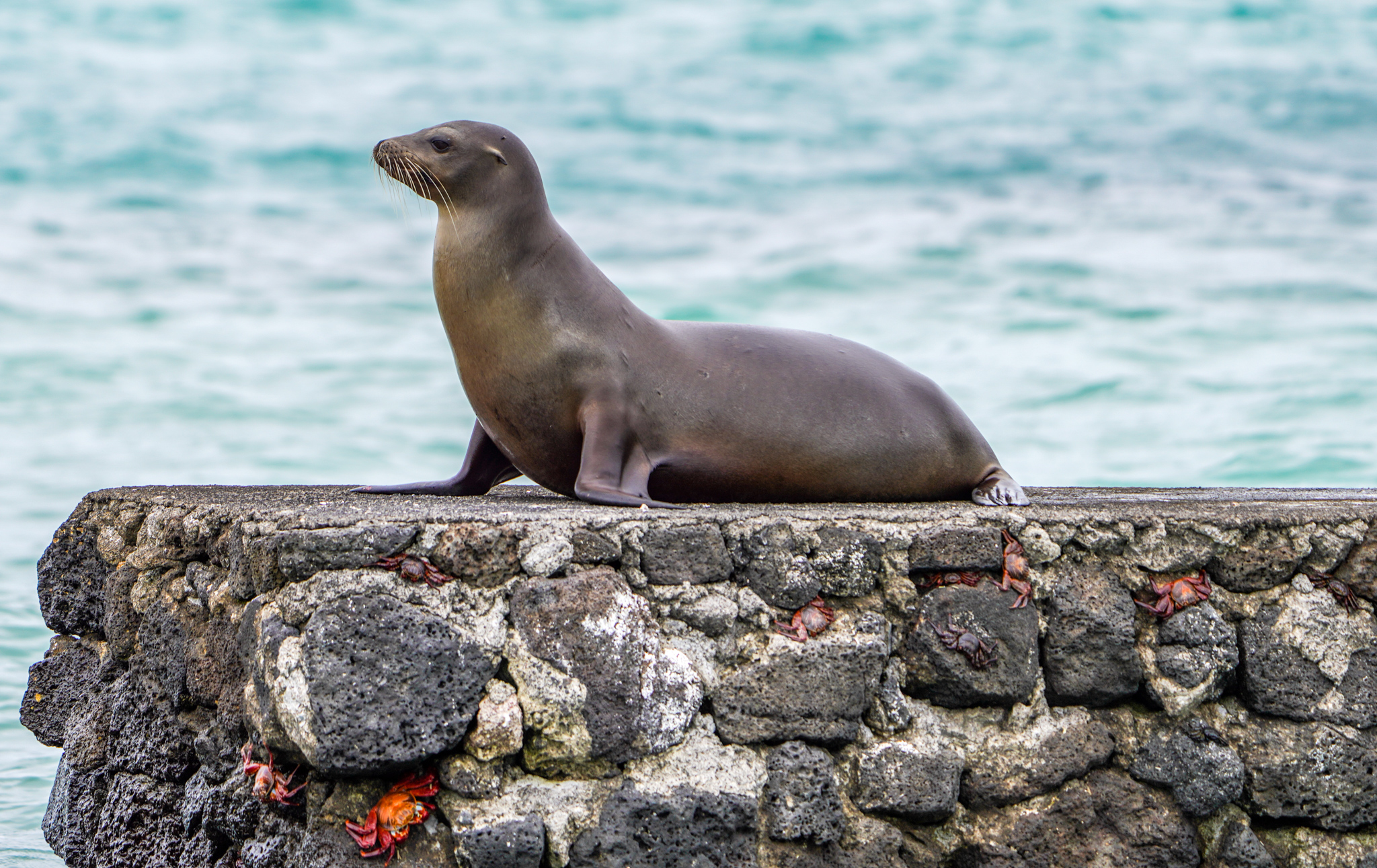The trouble with having high expectations is that an impressive experience must necessarily follow lest disillusionment takes hold. I am not sure I had specific expectations about our trip to the Galápagos, but I had an overall expectation that it would be an amazing experience, mostly because everyone says it is. Even now, after having returned, I don’t think I can pinpoint exactly what made the experience so good. Usually it’s the food and people that make a place stand out for me, but neither are particularly noteworthy there. On reflection, I think it is some combination of the beauty of the landscapes, interesting geological history, the significance of its inspiration to scientific development, coupled with the way tourism is managed so that no place is ever overcrowded, and of course, the incomparable way in which you can interact with a unique assemblage of endemic wildlife. Mostly though, it must be the widlife. Mostly though, it must be the wildlife.
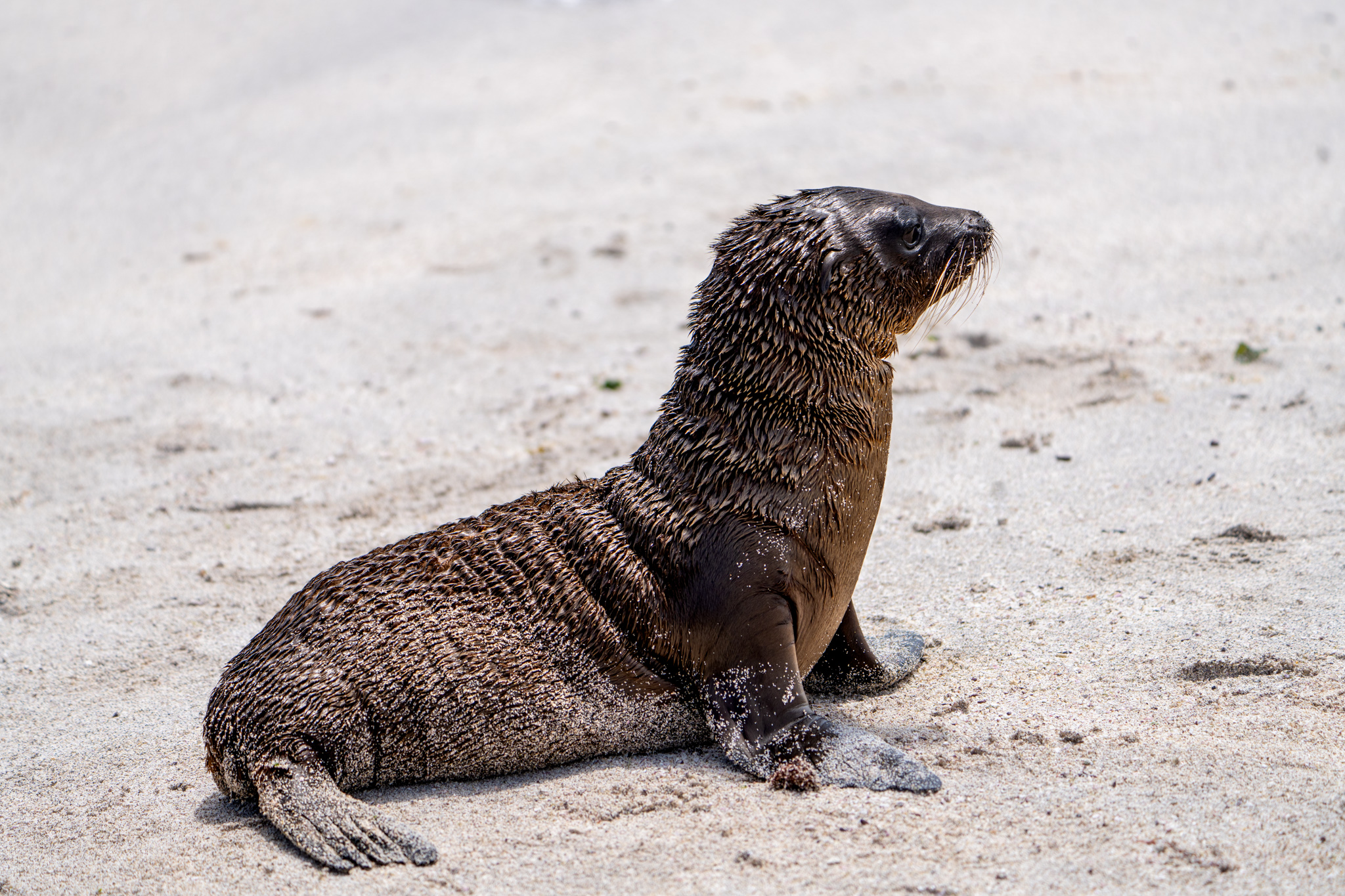
A juvenile Galápagos sea lion
It is a singular destination for experiencing nature - in an isolated archipelago sheltered from the dissonance found across so much of the rest of the planet. It is therefore not hyperbolic to say our time in the Galápagos was one of the best travel experiences of my life.
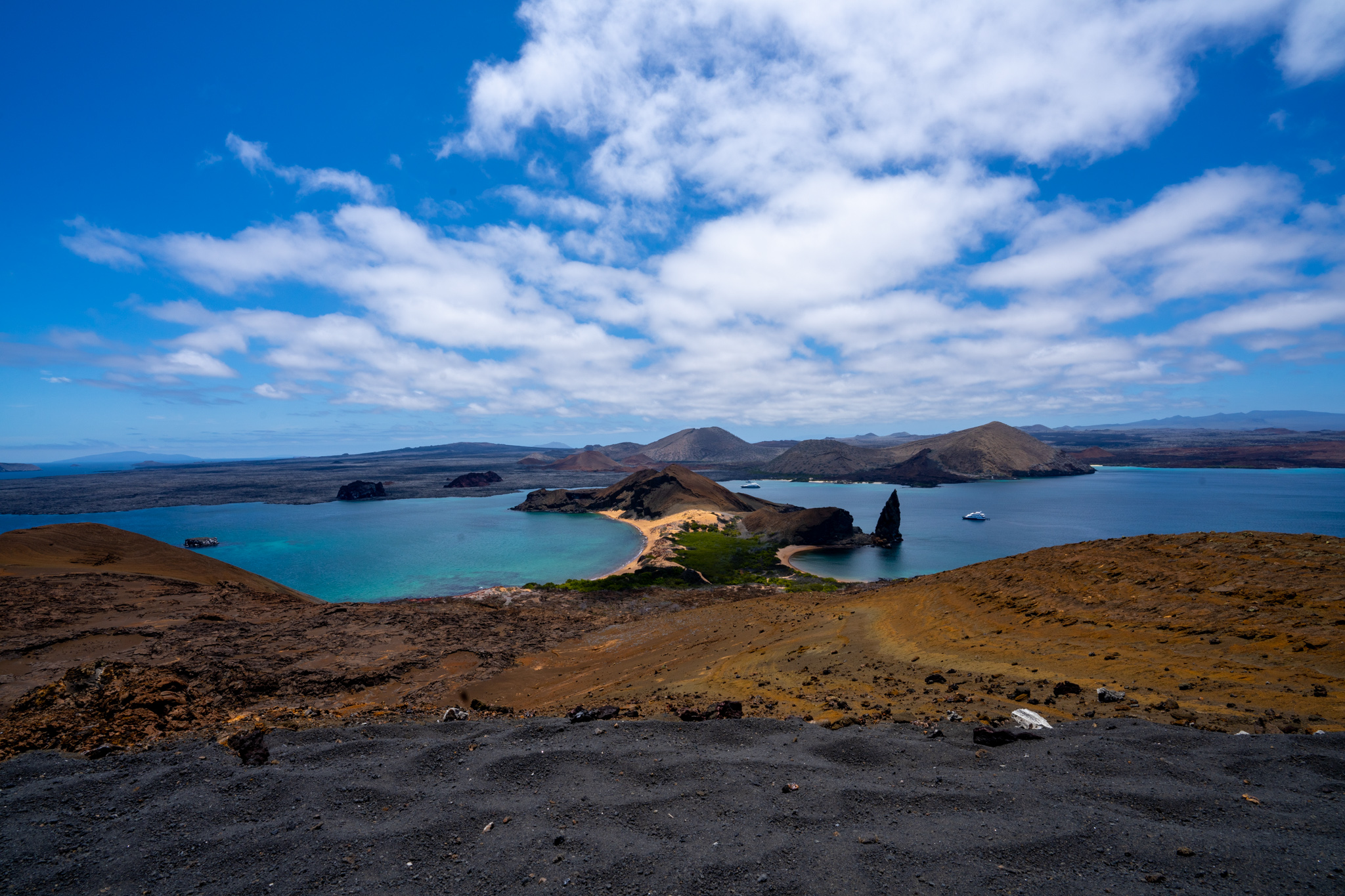
No place on Earth compares to the Galápagos. This remote archipelago of 19 islands stretching over 138,000km² in the equatorial Pacific Ocean is utterly incredible. Deserts, rainforests and polar waters converge in a very small area creating a diversity of climates inhabited by unique flora and fauna. This variety has created opportunities for the few animals and plants that have managed to survive here. They arrived, largely by mistake, adapted to the niche microclimates and then flourished.
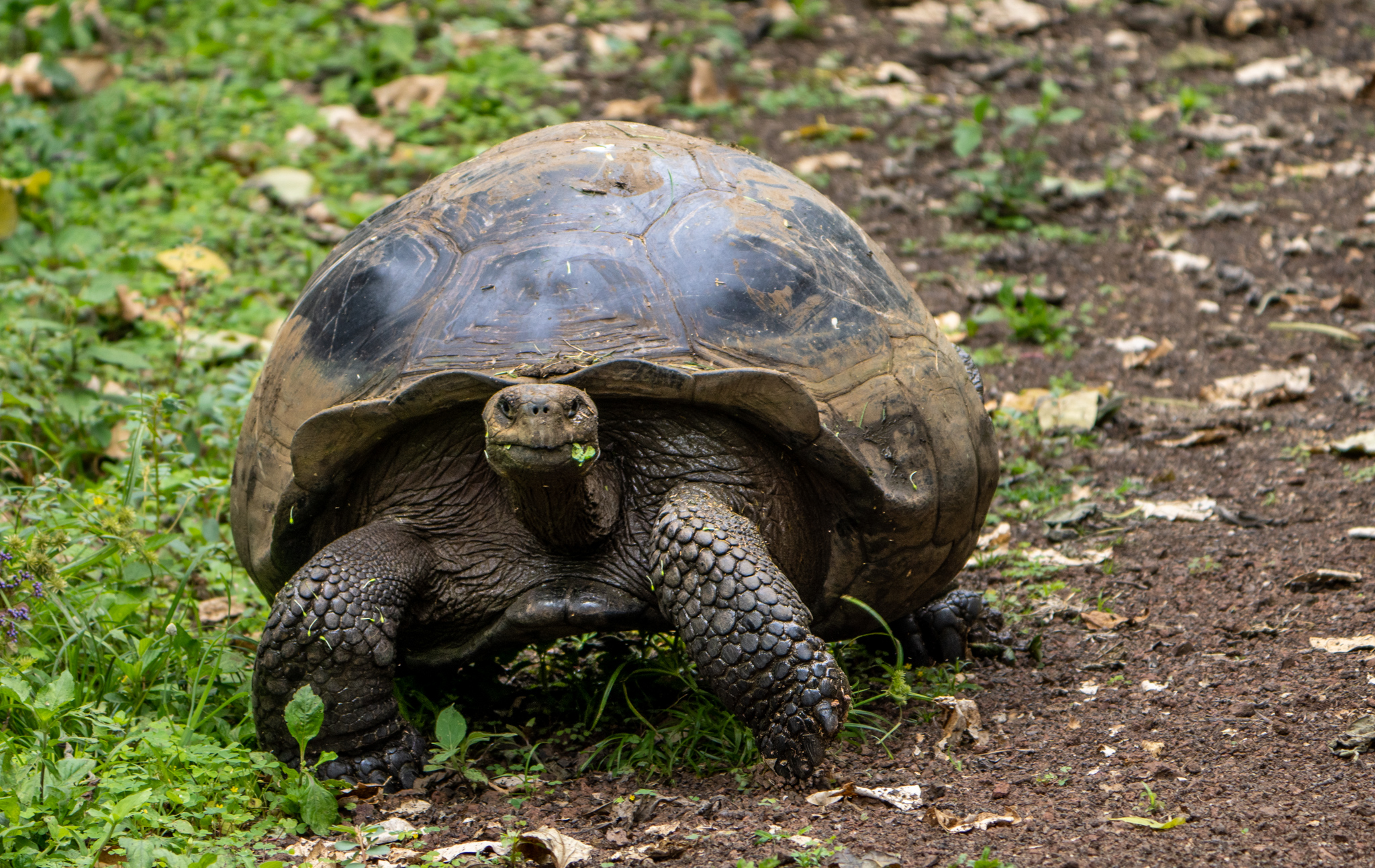
A Galápagos tortoise
The journey from the airport on Baltra Island to the town of Puerto Ayora on Santa Cruz island, the most populated island, alone is sufficient to demonstrate the diversity of the Galápagos archipelago. Arriving at the airport, it was sunny and warm, the sky cloudless and the landscape a flat and arid desert of black lava rocks dotted with cacti. After leaving the airport, all passengers take a bus down to the boat terminal where they are then loaded onto a small boat, all suitcases and provisions for the island piled on the rooftop of the boat, to cross the channel to Santa Cruz Island.
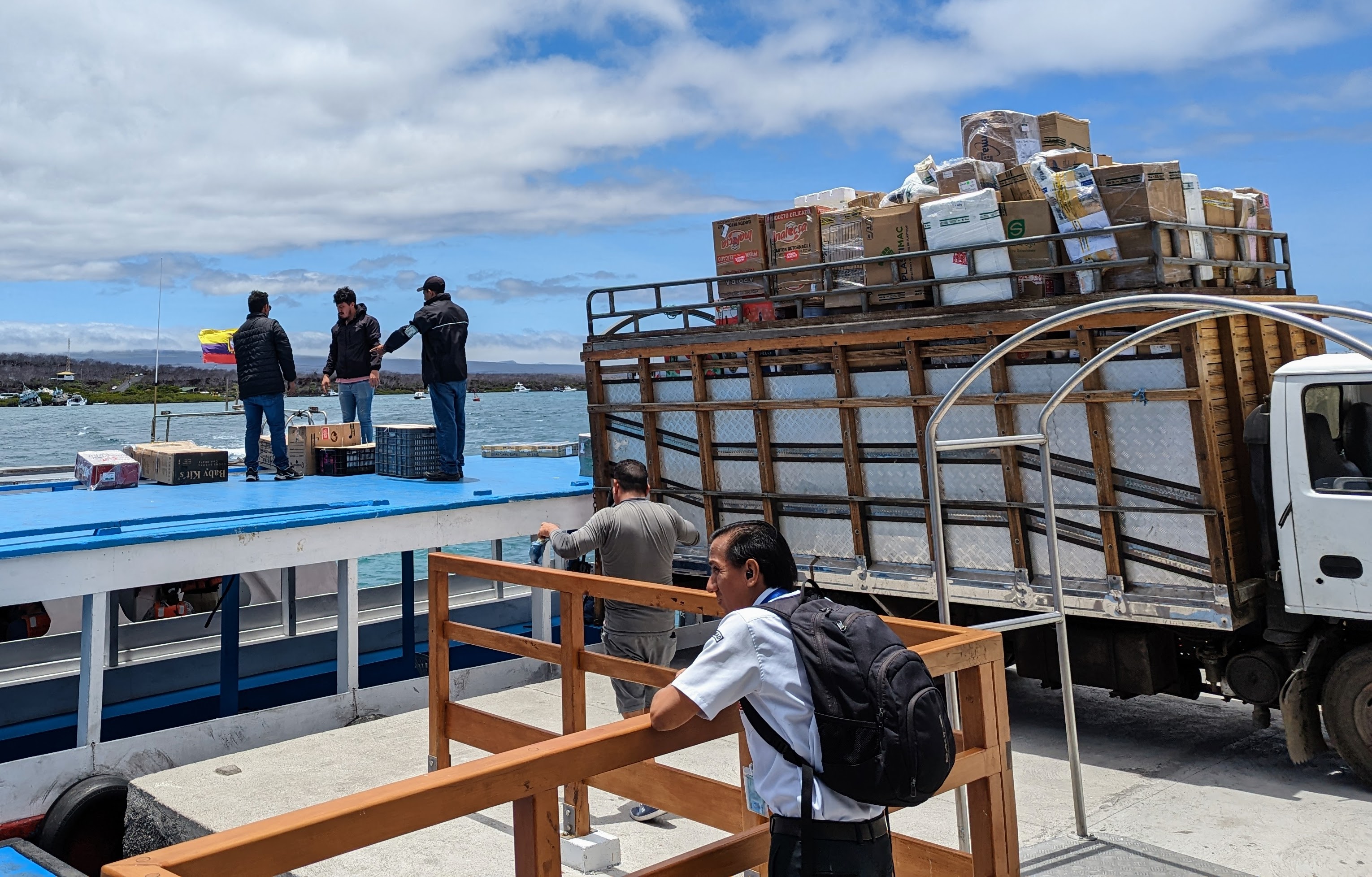
Loading the boat to cross the channel from Baltra island to Santa Cruz island
On the other side of the channel, we get in a ute and drive along the island’s only traversing road, ascending in height as we approach the centre of the island. As we do, everything changes. The cacti disappear and trees appear, the desolate rocky terrain is replaced by forest, the blue sky is covered by clouds, and a low hanging mist drizzles everything with moisture. Most of the archipelago is marked by a scarcity of rain but there is lush vegetation growing in the highlands of those larger islands with high enough altitude to trap weather systems. But nearly as quickly as the vegetation appeared, it is gone again, as we descend back towards sea level on the other side of the island.
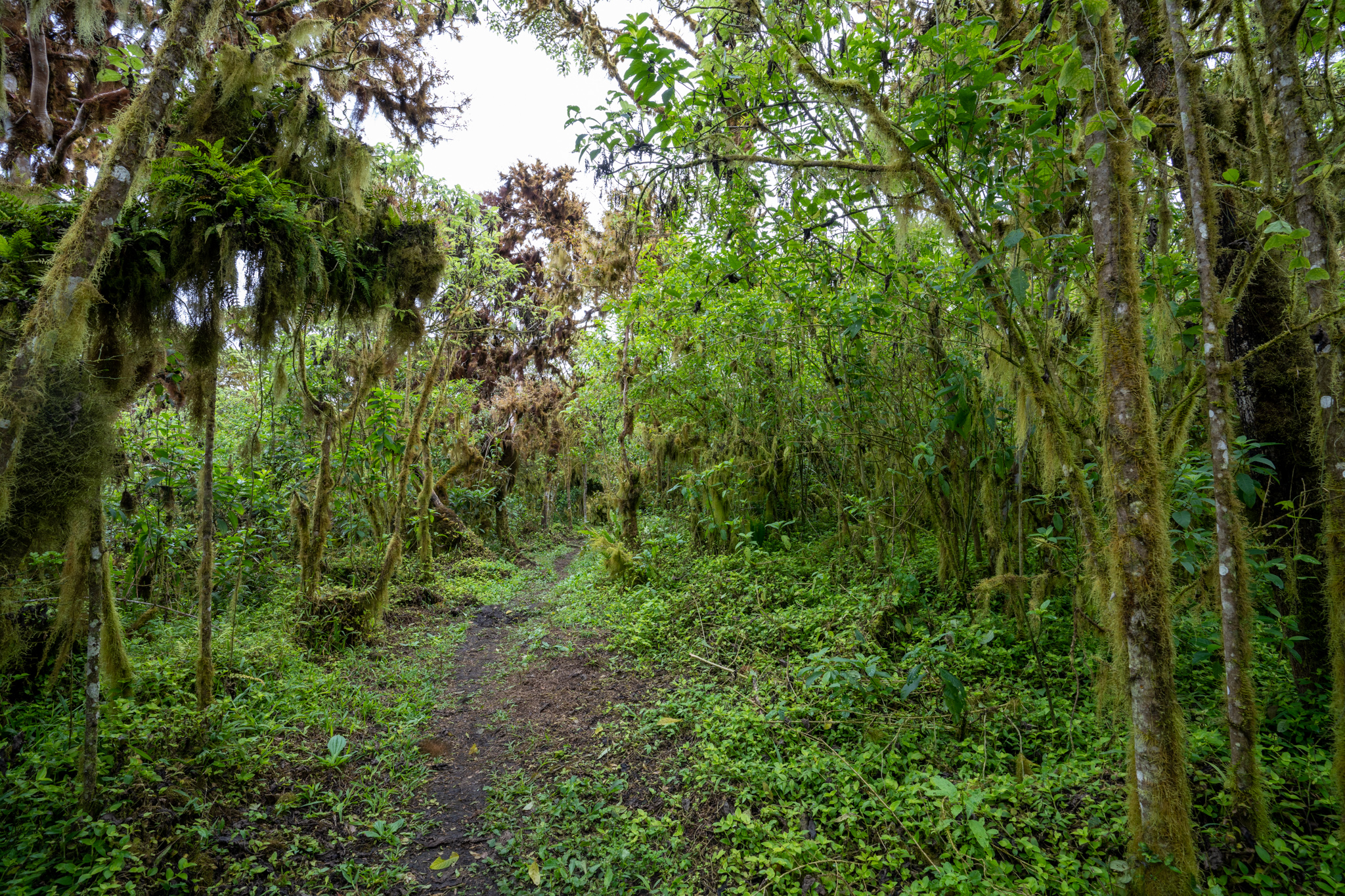
The lush highlands of Santa Cruz
In just a few kilometres the landscape and weather completely changes, and that is the story of the Galápagos islands - an archipelago of distinct and varied geographies and microclimates, formed by lava, lying at the meeting place of three major ocean currents, accidentally inhabited by wind and sea-drift species, and then populated by those unique few that evolved to survive.
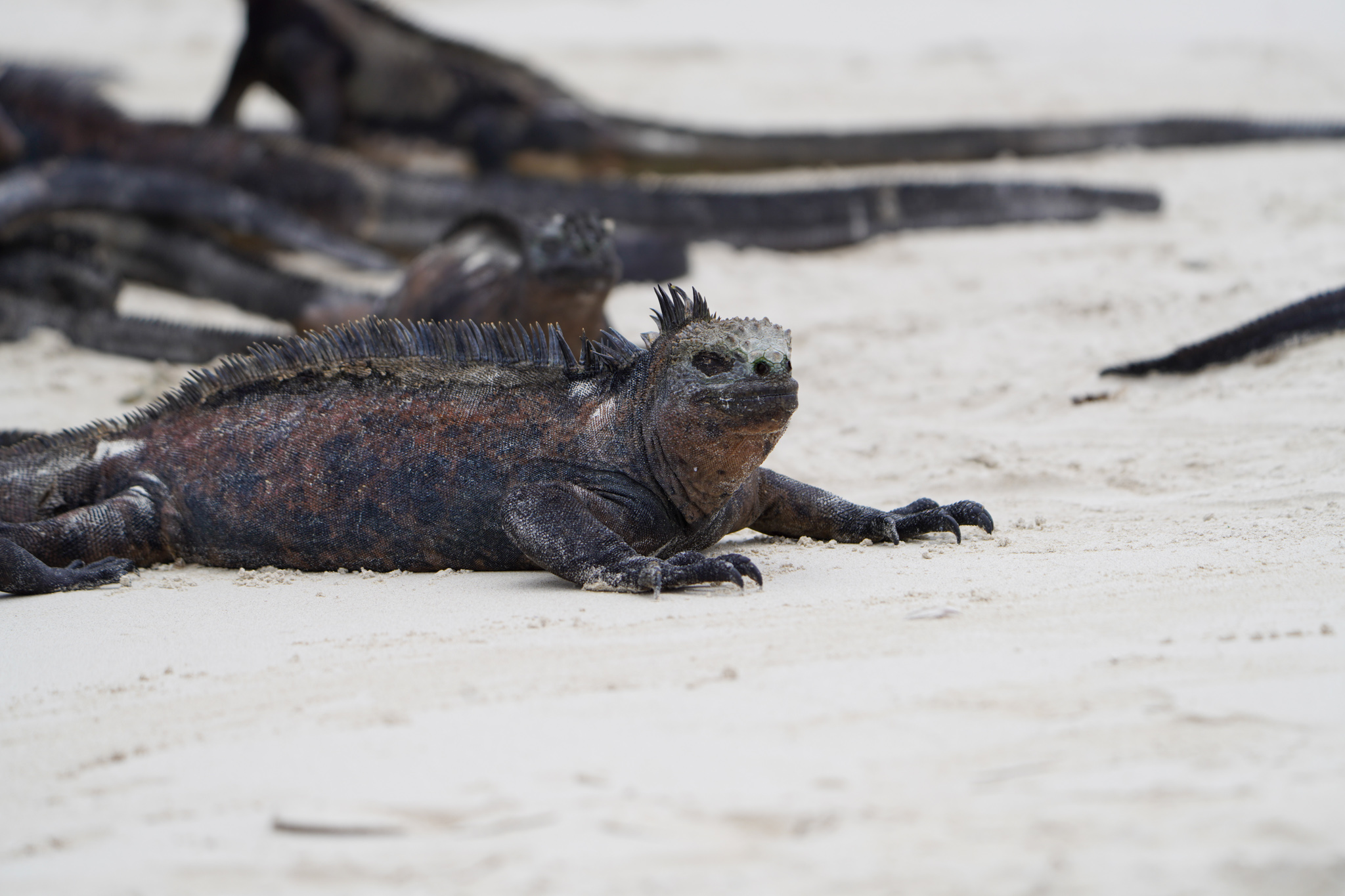
The Galápagos marine iguana
There are many endemic species in the Galápagos; creatures not found anywhere else on the planet. Having arrived by sea or air, there are no land mammals. The reptiles and birds dominate the land and because they have no real predators, like the jungle cats of their mainland ancestors, this is one of the few places on Earth where the wildlife shows no fear of humans, allowing you to observe these animals in their natural habitats for up close personal encounters.
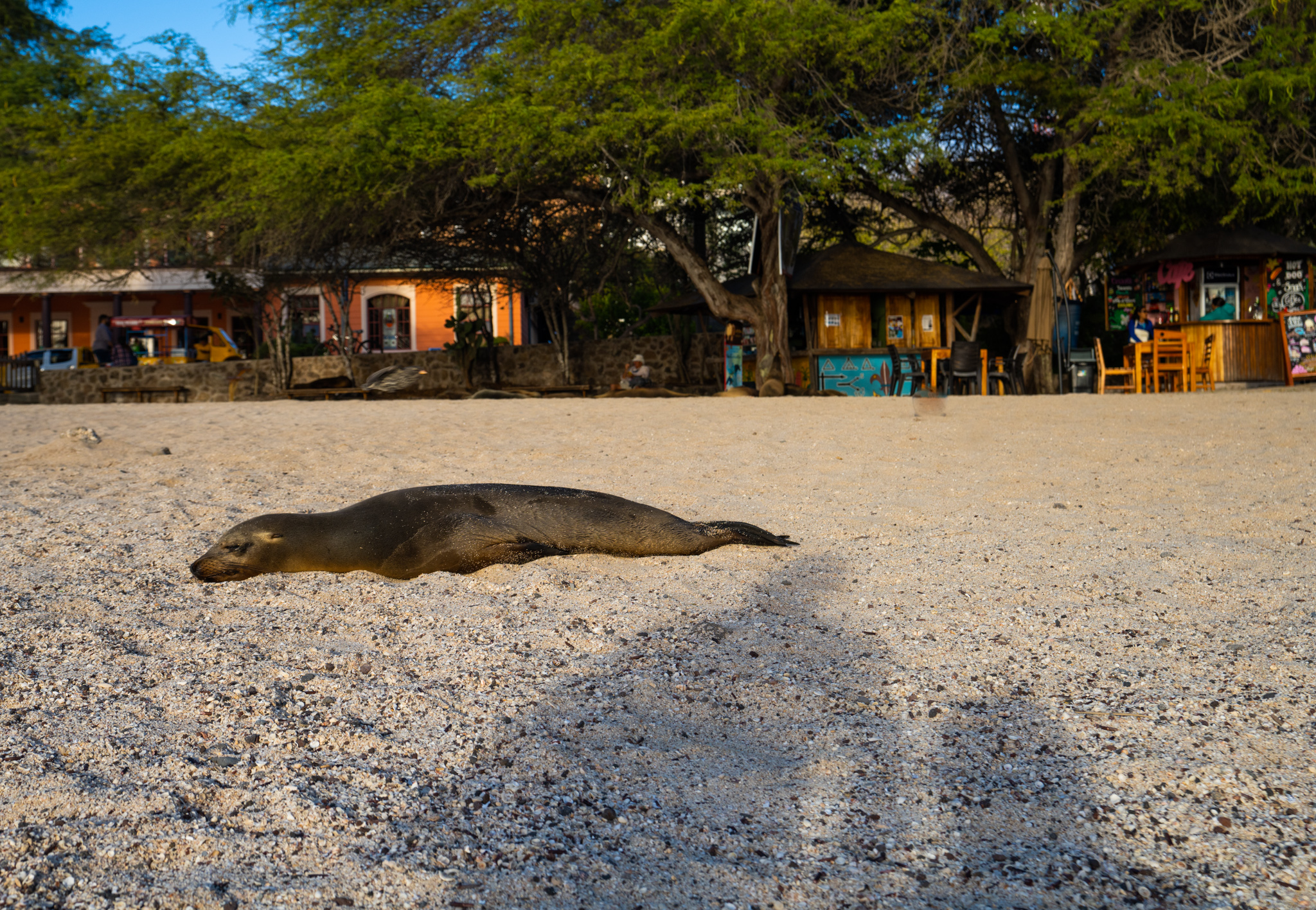
Sea lions occupy public spaces without fear
Some of the oddities that inhabit these islands include the Galápagos sea lion, blue-footed boobys, tropical penguins, marine iguanas, giant land tortoises, the waved albatross, and Darwin’s finches - a collection of different species endemic to the archipelago, and in some cases, to one only island.
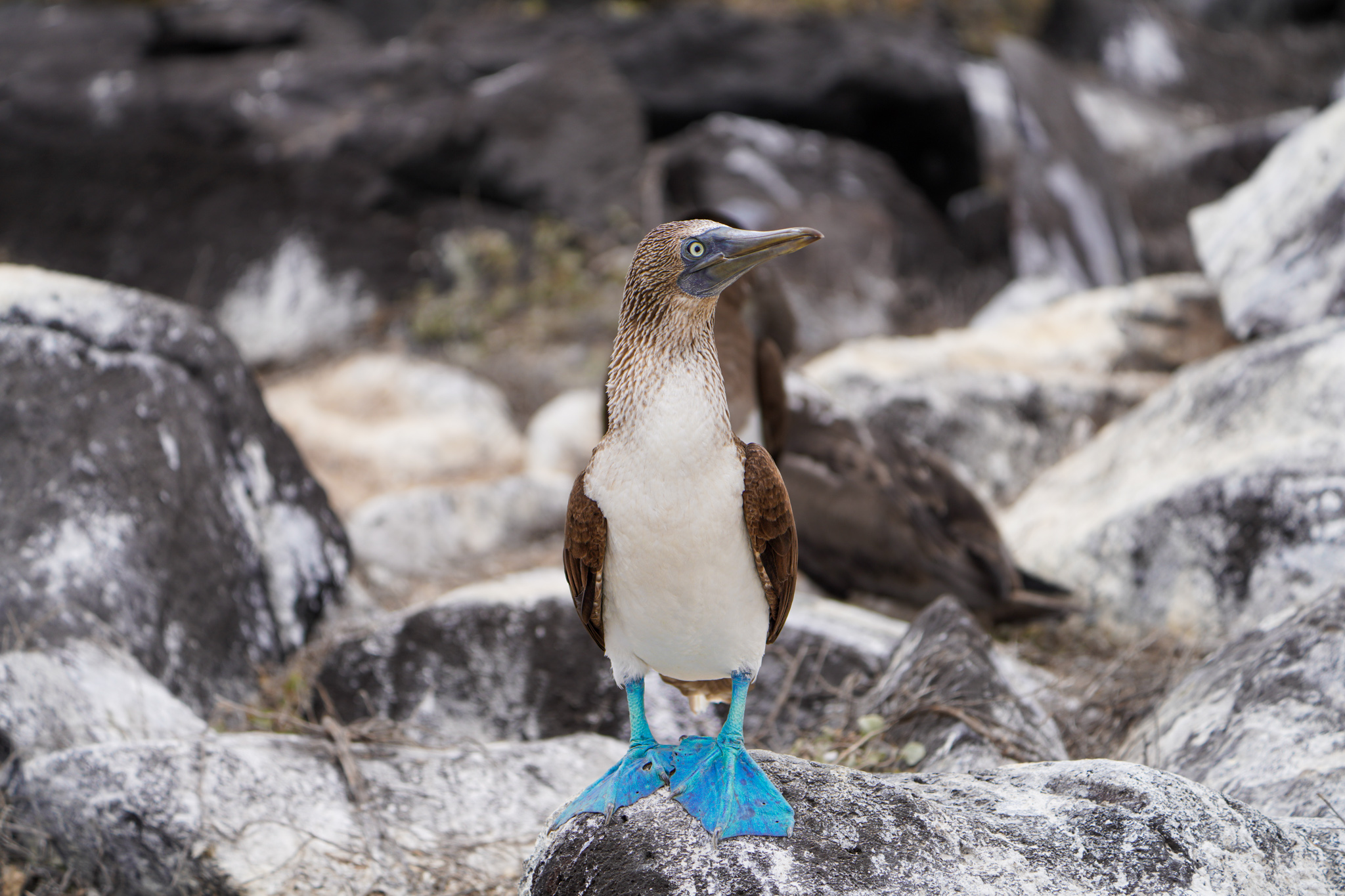
A blue-footed booby
After arriving in the main town on Santa Cruz we took a boat ride across the bay to our hotel, the Finch Bay Hotel. Although it was located on the main island, it could only be accessed by boat, and so each day we took a little dinghy back and forth, always managing to catch a sea lion or two at the dock.
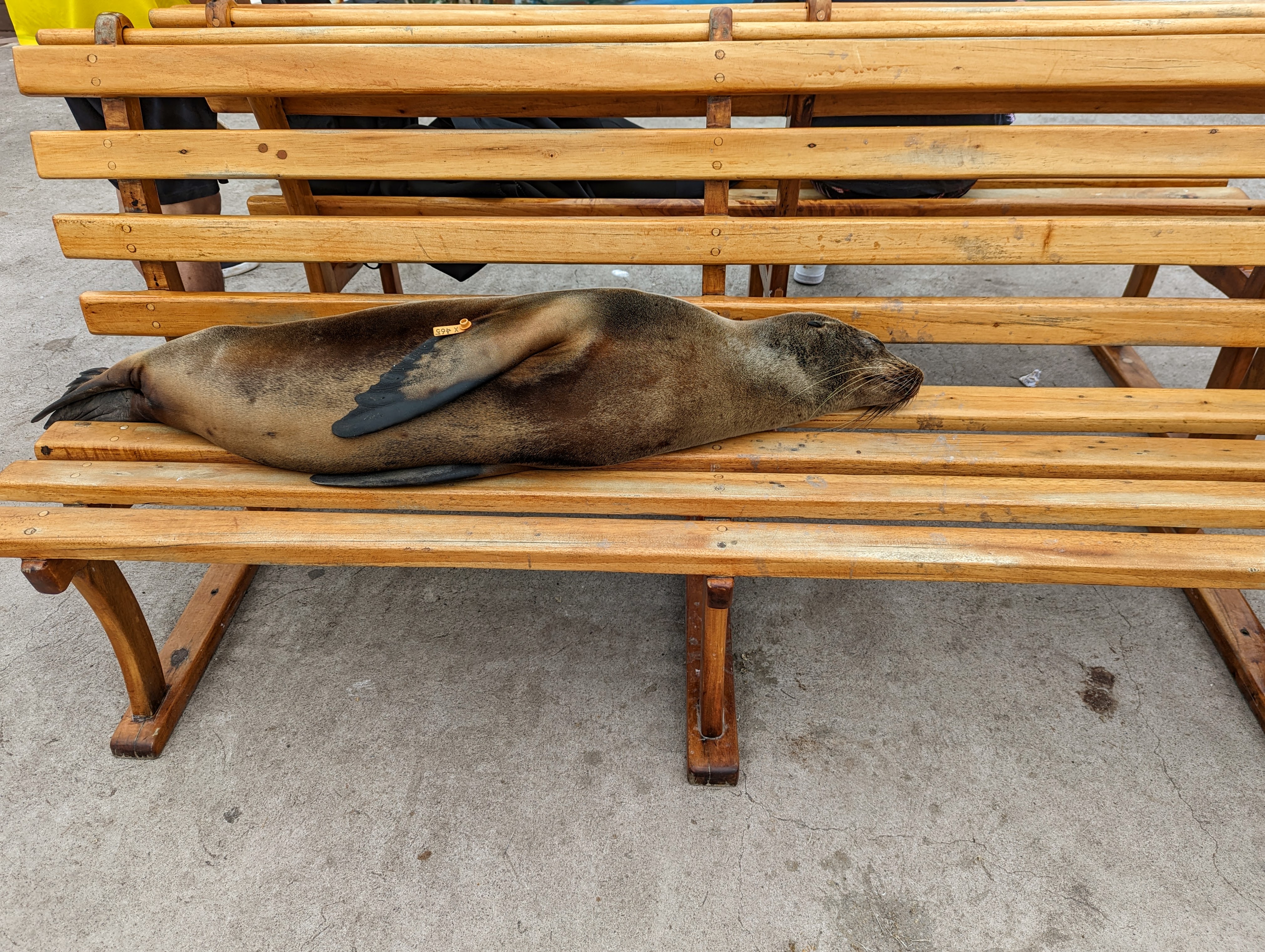
A regular at the Finch Bay boat dock
We stayed there for four nights. It was an exceptional hotel in a beautifully landscaped location behind a beach. On site was a highly-rated restaurant, pool-side cocktail bar, outdoor hot tubs and lovely rooms. After checking in and having a late lunch we then went for a hot tub to warm up.
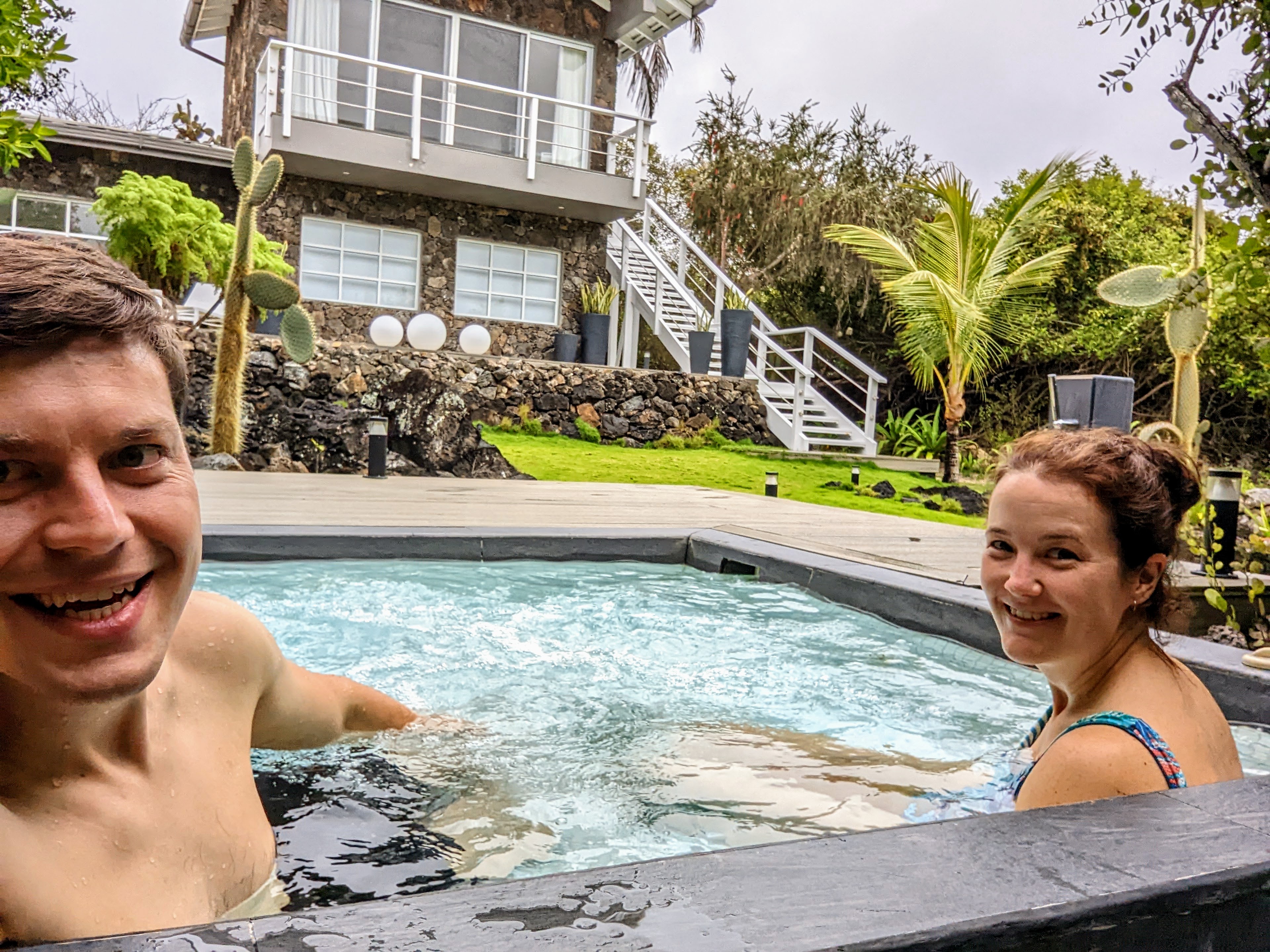
Enjoying the hot tub at the Finch Bay hotel
Despite sitting on the equator, the weather in the Galápagos is relatively mild and the water is always cold, thanks to the Humboldt current that draws frigid water up from the Antarctic waters along the coast of Peru. It means wetsuits are needed for snorkelling, but it also bathes the Galápagos with nutrient-rich waters, enabling the growth of spectacular marine life.
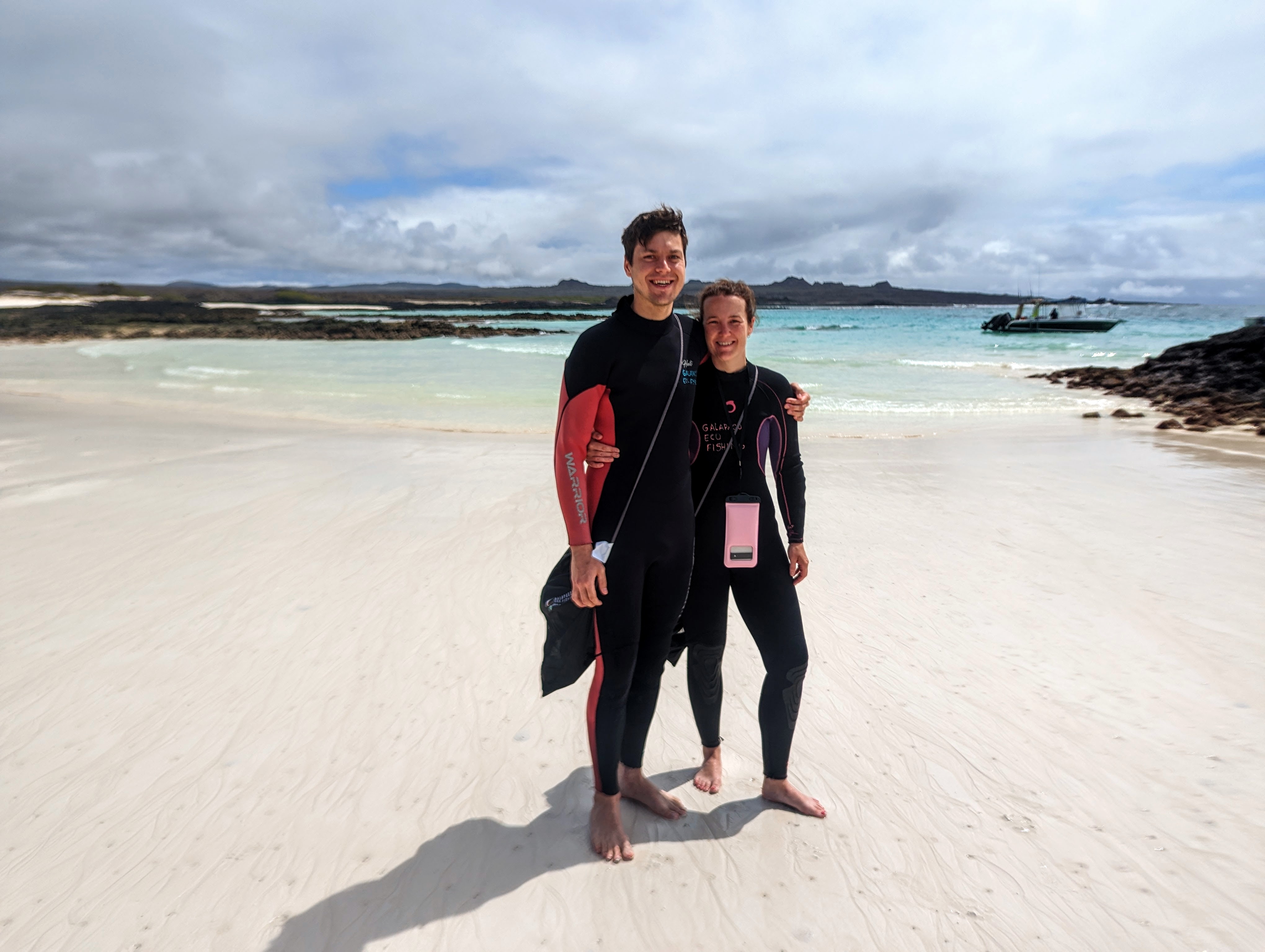
Rocking the wetsuits
After a relaxing soak in the hot tub situated among the mangroves, watching frigatebirds fly overhead, we enjoyed a few cocktails at the bar before dinner and bed. The hotel restaurant is recognised as one of the best restaurants on the island and we enjoyed delicious meals there every night with one of our favourite dishes being an Ecuadorian soup called locro de papa. We had it elsewhere in Ecuador but this one was by far the best.
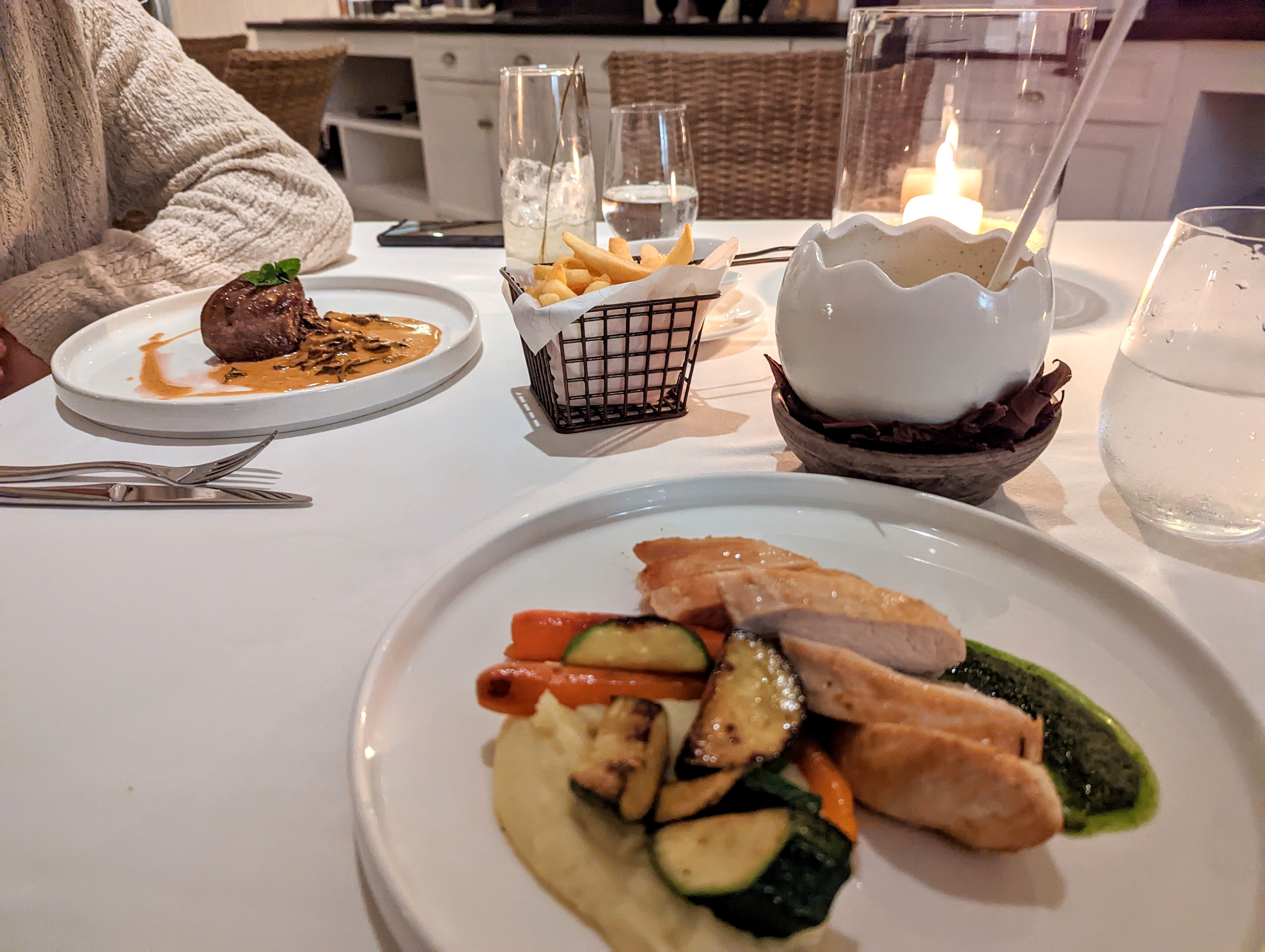
One of many delightful dinners with cocktails at the Finch Bay restaurant
We spent our first full day exploring Santa Cruz. We walked from town to Tortuga Bay, a beautiful white sand beach populated with the famous Galápagos marine iguanas. It is one of the most amazing species in the Galápagos. They arrived from South America as land iguanas, most likely adrift on vegetation rafts from the Amazon. As reptiles, they could endure the heat and lack of water on the open ocean for weeks, and so some arrived on the islands, survived, adapted, and eventually evolved into the marine creatures they are today; learning to swim, changing their snout to adapt to a diet of seaweed, developing a special gland to allow for the extraction of excess salt, reducing their heartbeat and constricting blood vessels to avoid temperature loss. They are found on every island in the archipelago, but nowhere else on Earth.

A marine iguana at Tortuga Bay beach
After our morning with the iguanas, we walked back into town and had lunch at Almar, a restaurant overlooking the water where we could watch sea lions swimming, snoozing and snogging.
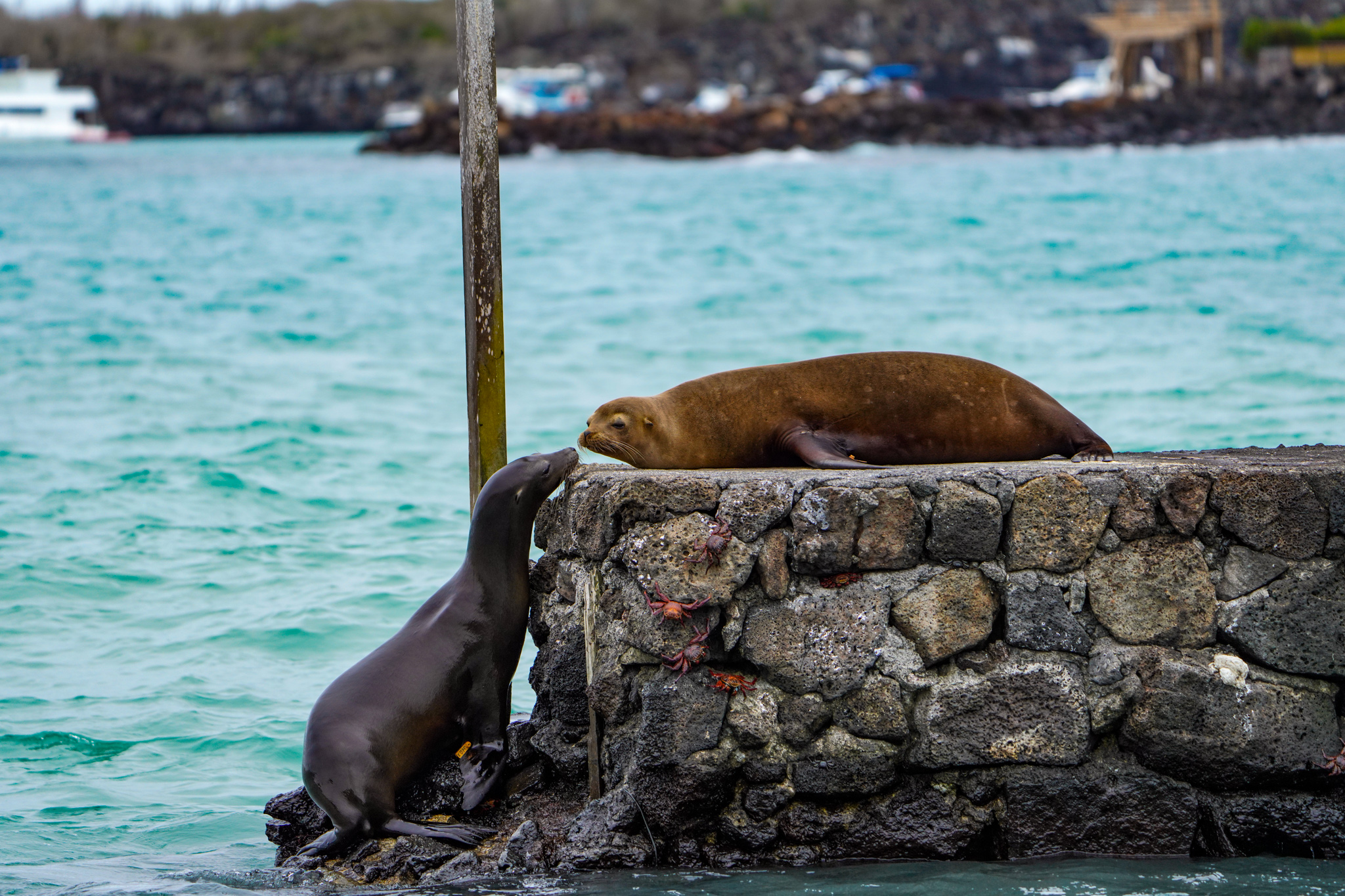
Enjoying the sea lion entertainment at Almar
We also saw our first blue-footed booby here. These birds appear rather comical on land due to their unreal looking bright blue feet, which they use to attract females with an amusing mating dance. The shade of blue is indicative of how well the male can feed himself, and so the more turquoise his feet are, the better catch he is. But they are far from comical in flight as they transform into spectacular plunge divers, being one of the few species of birds capable of high speed diving into the ocean to catch their food.
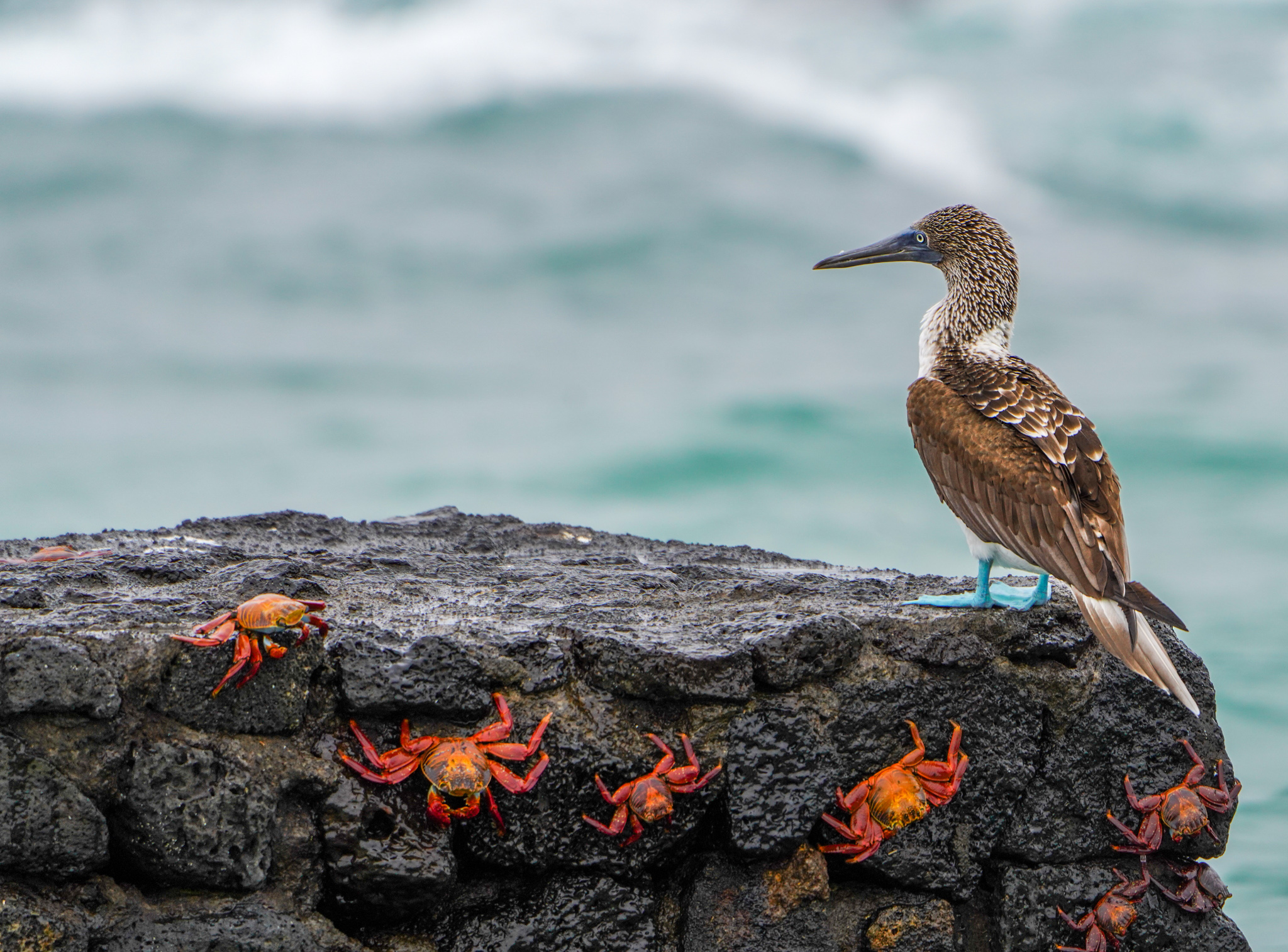
Our first blue-footed booby, hanging near restaurant Almar
After lunch we had our first go at snorkelling in the quiet beach in front of our hotel. We wanted to practice before our trip the next day where we would be snorkelling in the ocean since we hadn’t snorkelled for years. Even with wetsuits on, the cold water was piercing and so another hot tub was very welcome afterwards to warm up before dinner and an early night to bed.
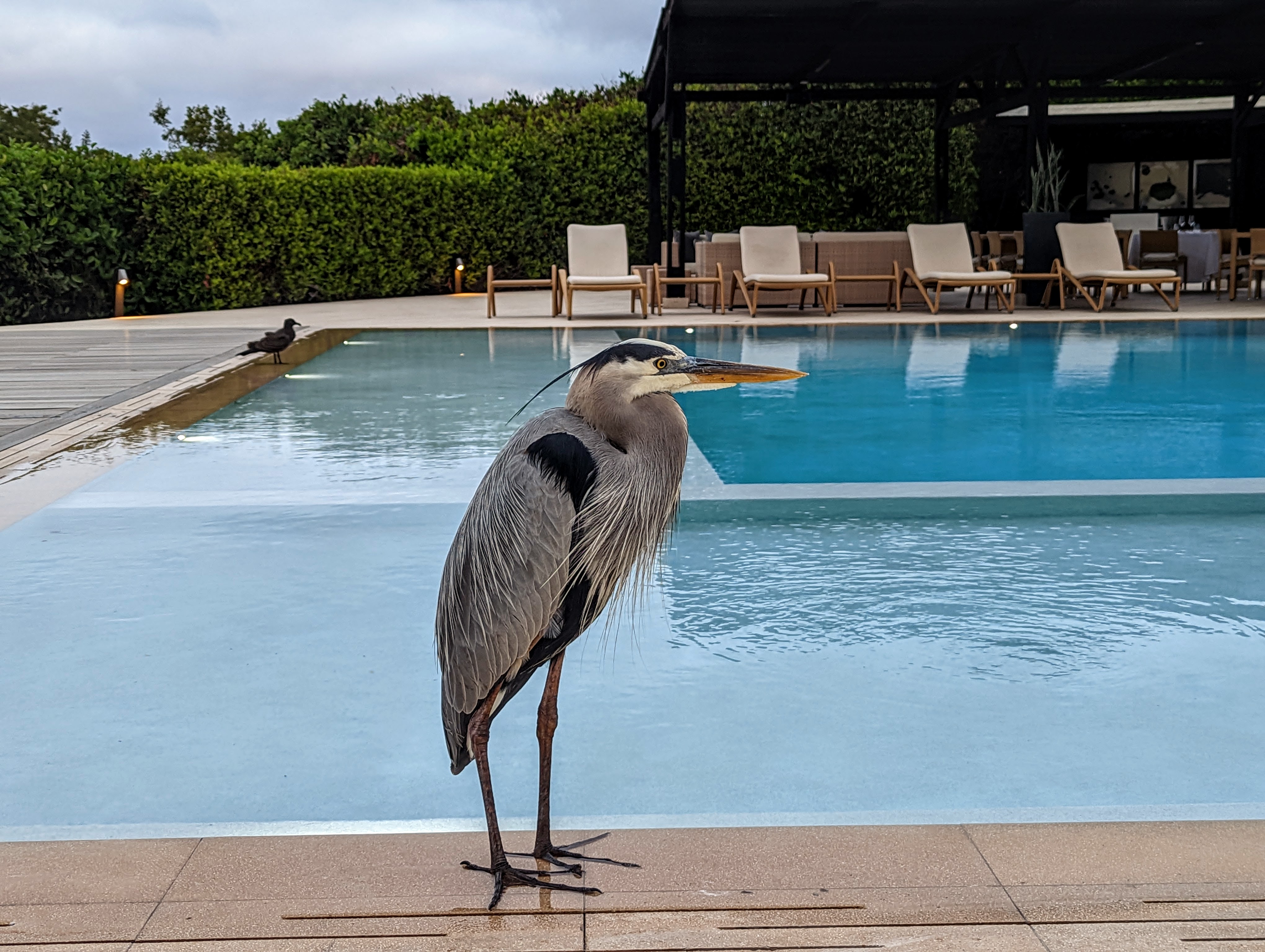
We weren't the only ones who liked to come down to the pool bar for an evening drink
The next day, we rose early for a day trip to Bartolomé island. We met our guide at 6.50am and rode in a minivan back across the island to the boat terminal where we boarded our yacht for the day. Along with the rest of our small tour group, we headed into open water for the two hour journey to Bartolomé. On arrival at the island, we anchored a little way offshore and took a small motor boat to land. We spent a couple of hours hiking, learning all about the formation of the islands from our expert guide, until we eventually reached the summit for a spectacular view across the archipelago.
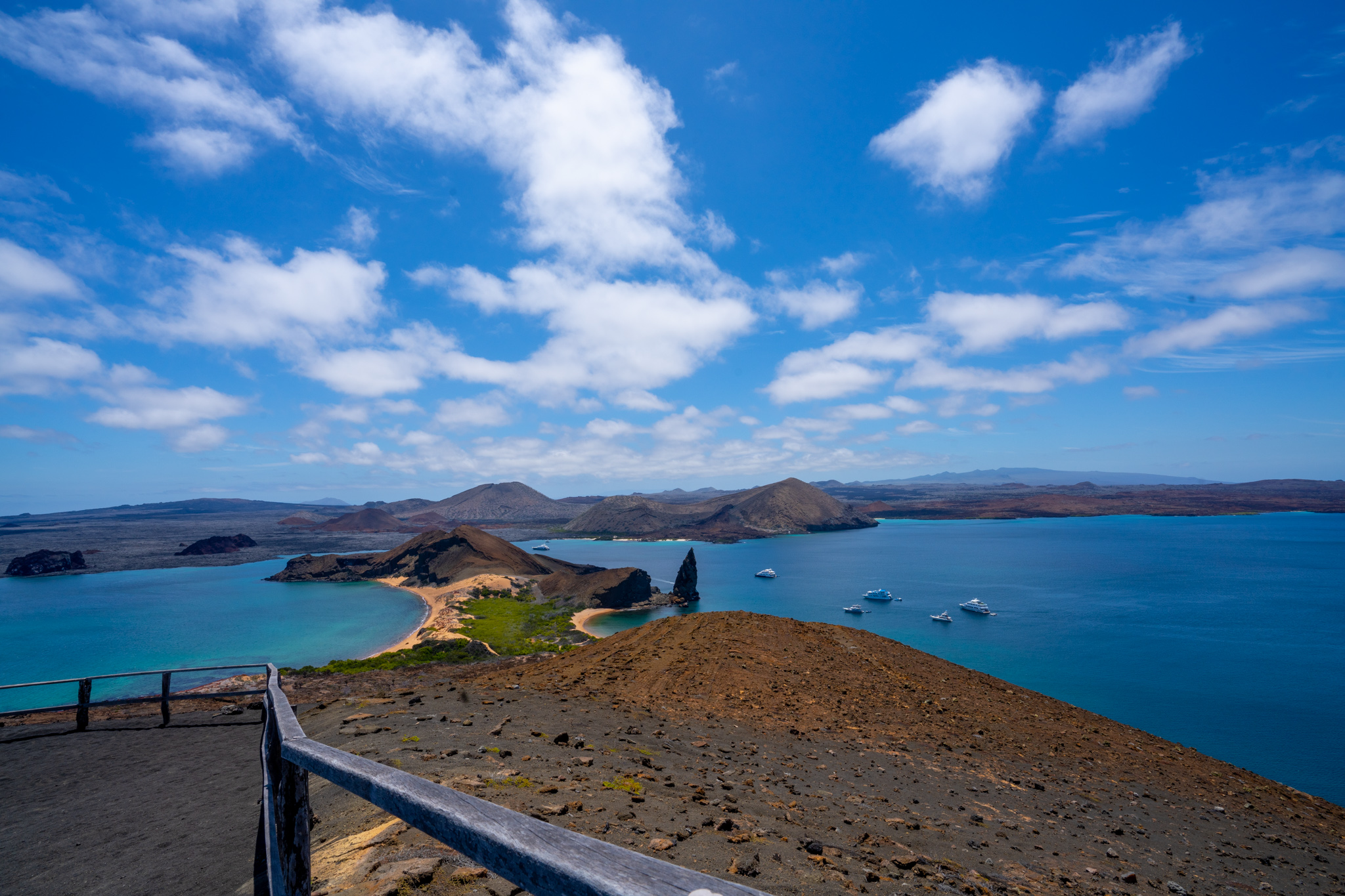
A view from the top of Bartolomé island
After that we cruised around the coast in the small motor boat looking for penguins. The Galápagos penguin is another small evolutionary miracle. They are the only penguins that live on the equator, having arrived here by accident, riding the Humbodlt current up from Antarctica some eons ago. They are the rarest species of penguin in the world and can survive on the equator despite their antarctic origins due to their adaptations; which include shedding feathers to lose heat, shading their feet from the sun and laying their eggs in ancient lava tubes (because there is no sand on this island to bury the eggs under). We didn’t spot any and so we returned to the yacht, a little disappointed, to change into our wetsuits for snorkelling.
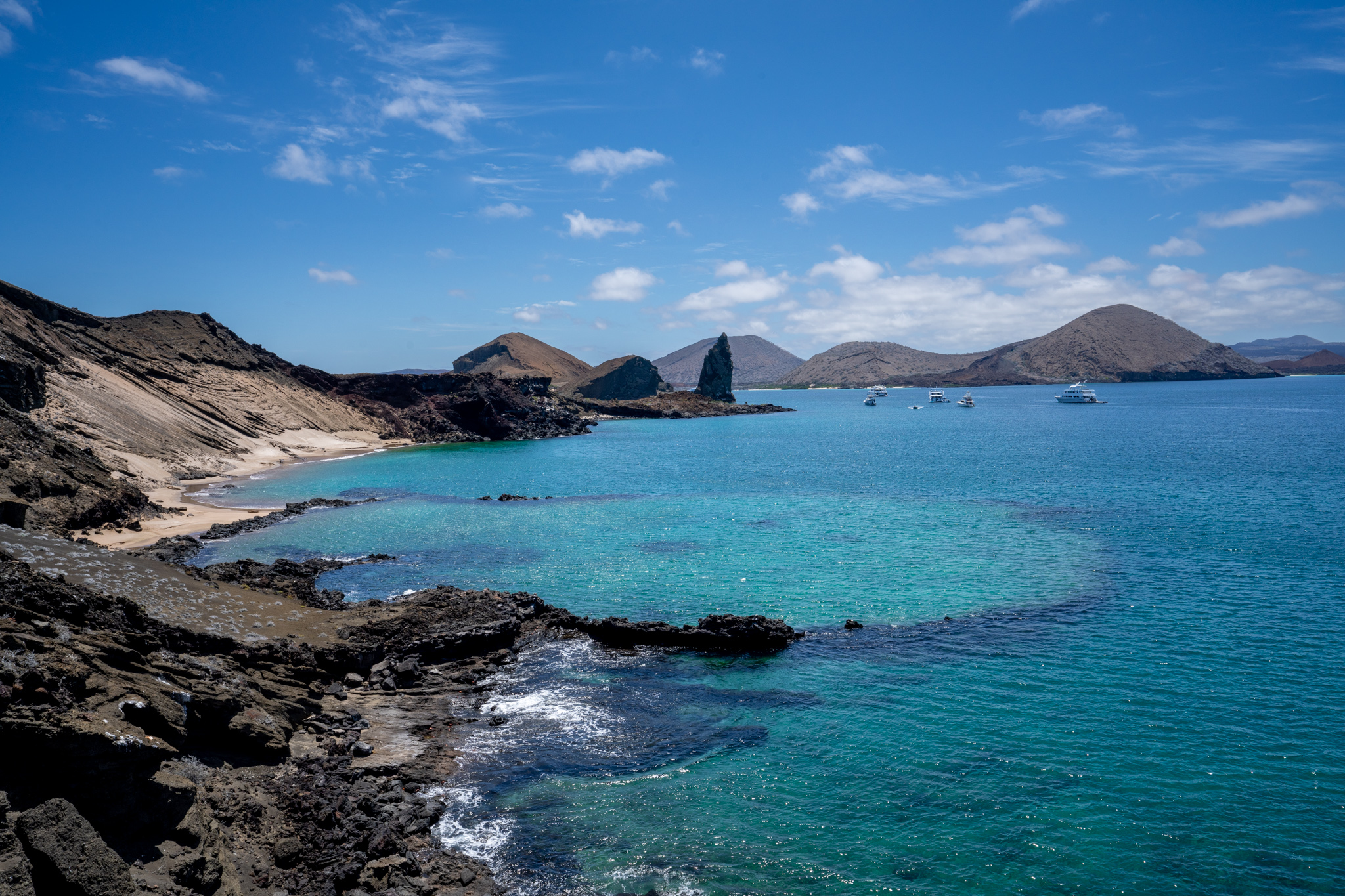
Our beautiful snorkelling location
The motor boat took us near a rocky outcrop, where we dropped into the icy water. Despite the 3mm wetsuit, the water felt cold and goosebumps instantly appeared on my exposed skin. But the sights below the surface took the cold from my mind. We spotted a white tip shark slinking along the ocean floor below the shadow of the boat and as we floated above the rocks, we saw an array of coloured fish darting in and out of their hiding places. But the best moment of all was when a little tuxedoed bird dropped off a rock into the water right next to us. We watched the penguin glide along the surface, then dip down and rocket through the water chasing after fish. We floated on the surface above, watching for a few minutes, hardly believing we were swimming with a wild penguin!
After about 40 minutes of delight, the cold was becoming too much and we rejoined our yacht where we were served a delicious hot lunch before preparing for our ride back to Santa Cruz.

Hot lunch on board our boat
On the way back, the wind picked up over the open ocean, and it was a wild ride. The waves were crashing onto the deck, loose objects crashing to the floor, the crockery clanging on the shelves, and one person revisited her lunch. As we neared port, and the protection of the larger island, the seas calmed, and we were joined by a pod of dolphins at the bow, riding our current as the sun cast a golden glow over the water, signalling the end of a wonderful day.

Watching the dolphins play at the bow
The following day, we went up into the highlands where evidence of the islands’ creation is most apparent. When the undersea eruptions that formed the Galápagos islands were still active, the lava flows being ejected above the surface would roll down the hills towards the sea. As the lava flowed, the outer, slower lava would cool faster than the middle, faster lava and start to solidify, gradually forming walls of dried lava that enclosed the hotter, still flowing, lava within. When the lava stopped flowing, these walls would be left in place, becoming lava tunnels and magma chambers. These blackened rocky tunnels are found all over the archipelago, but in the highlands of Santa Cruz, these geological formations are so large that they are like caves you can walk through.
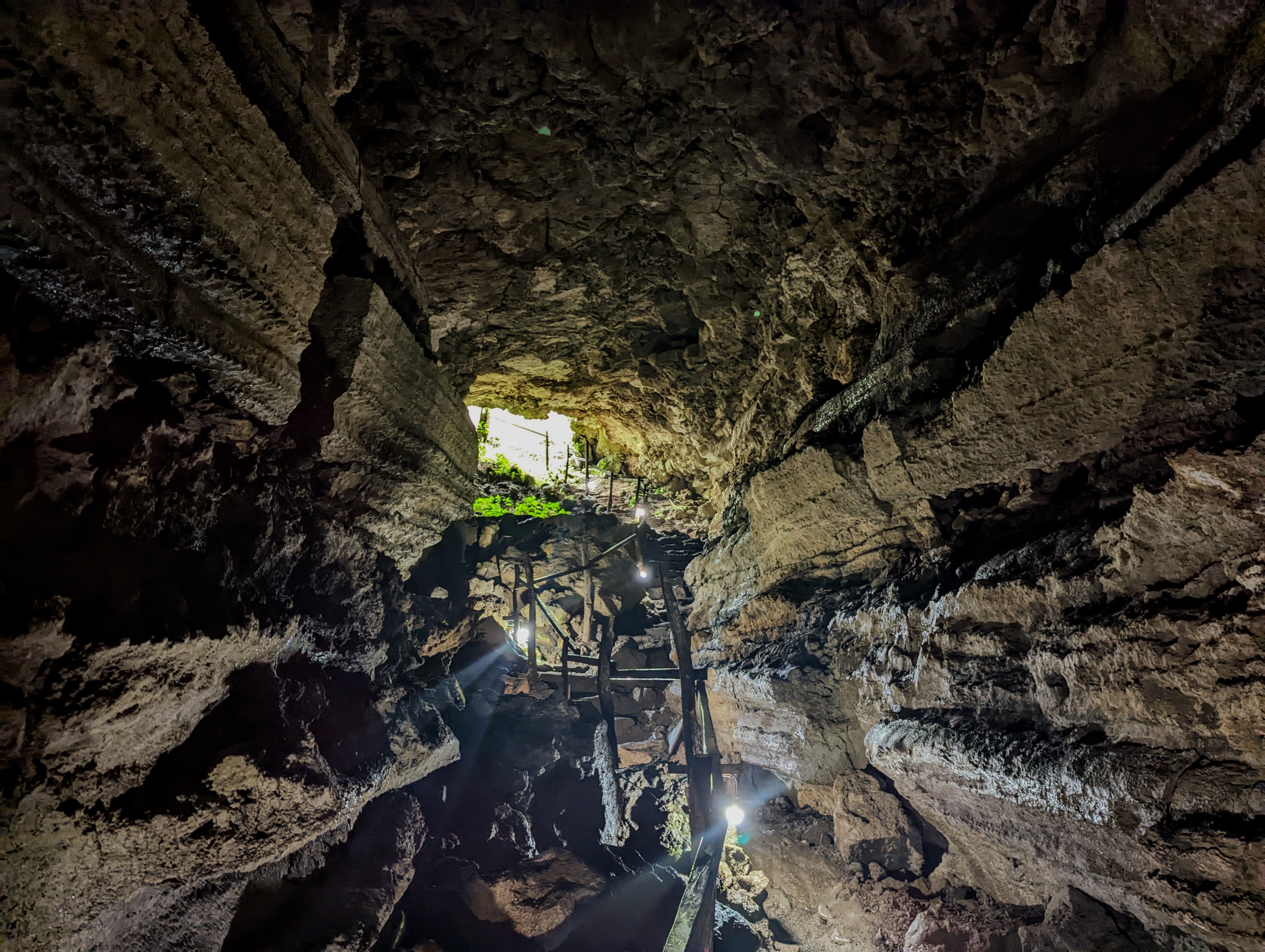
Walking through the lava tunnels at El Chato Ranch
These tunnels remain underground for thousands of years until eventually their roofs collapse due to erosion, which is the case with Los Gemelos, the twins. At Los Gemelos, you can see two large sink holes, where previous lava tunnels have collapsed. Now lush vegetation covers the crater-like formation, as a result of the rain that falls at this altitude.
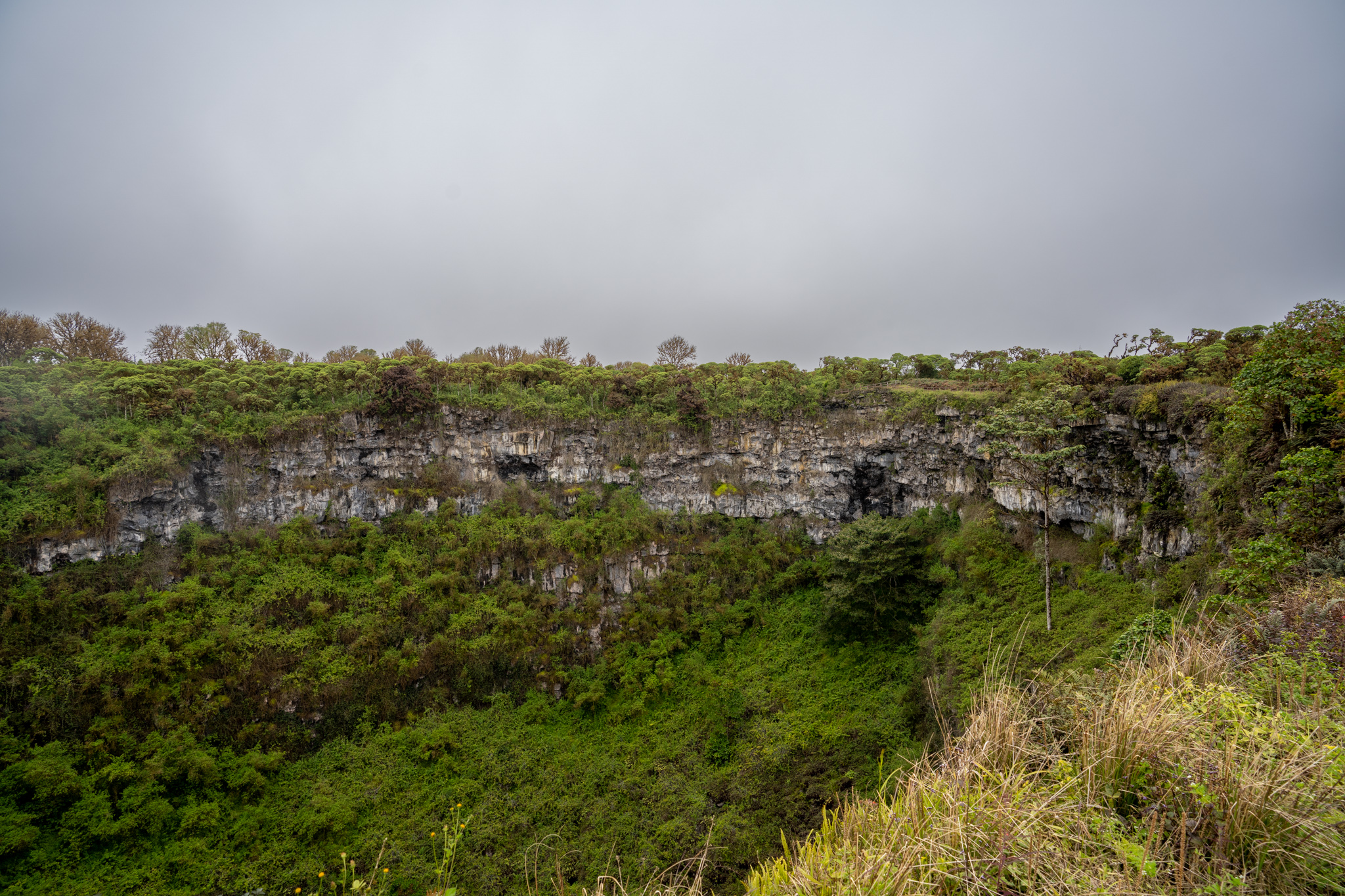
Walking around Los Gemelos
At El Chato Ranch we had a guided tour through the lava tunnels and the surrounding grassy highlands where giant Galápagos land tortoises lumber around in their natural habitat. They are the emblem of the Galápagos, so iconic that the Spanish explorers arriving at the islands hundreds of years ago applied their Spanish name for tortoise - galápagos - to the whole archipelago.
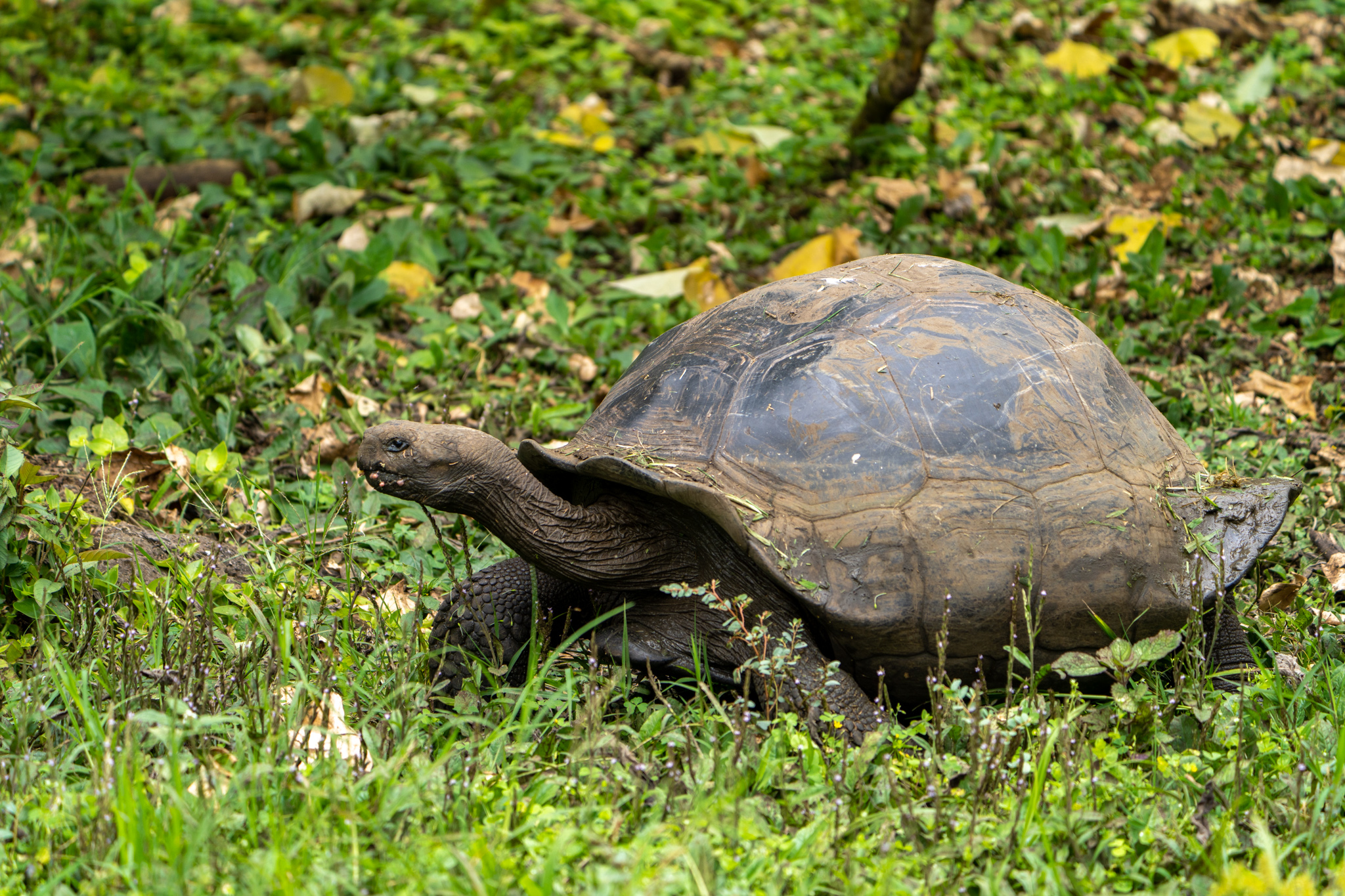
Giant land tortoise at El Chato Ranch
Once, hundreds of thousands of these magnificent animals roamed the islands, but during the 19th century their numbers dramatically declined due to over-exploitation by whalers who collected live tortoises by the hundreds to be stored on their boats for food on their long voyages. The population stablilised last century and is slowly starting to increase due to conservation. These unique creatures can live up to 200 years and weigh close to 400kg. They are found on most islands in the archipelago, but distinct sub-species occur from island to island, varying in traits such as their shell shape and size and the length of their neck.

Giant land tortoise at El Chato Ranch
In the afternoon, we went snorkelling at Las Grietas, a rock formation of two cliffs separated by an ocean water chasm. The still, clear, deep water provides a great place for snorkelling. We swam through the chilly gorge, observing the fish below and even spotting an eel.
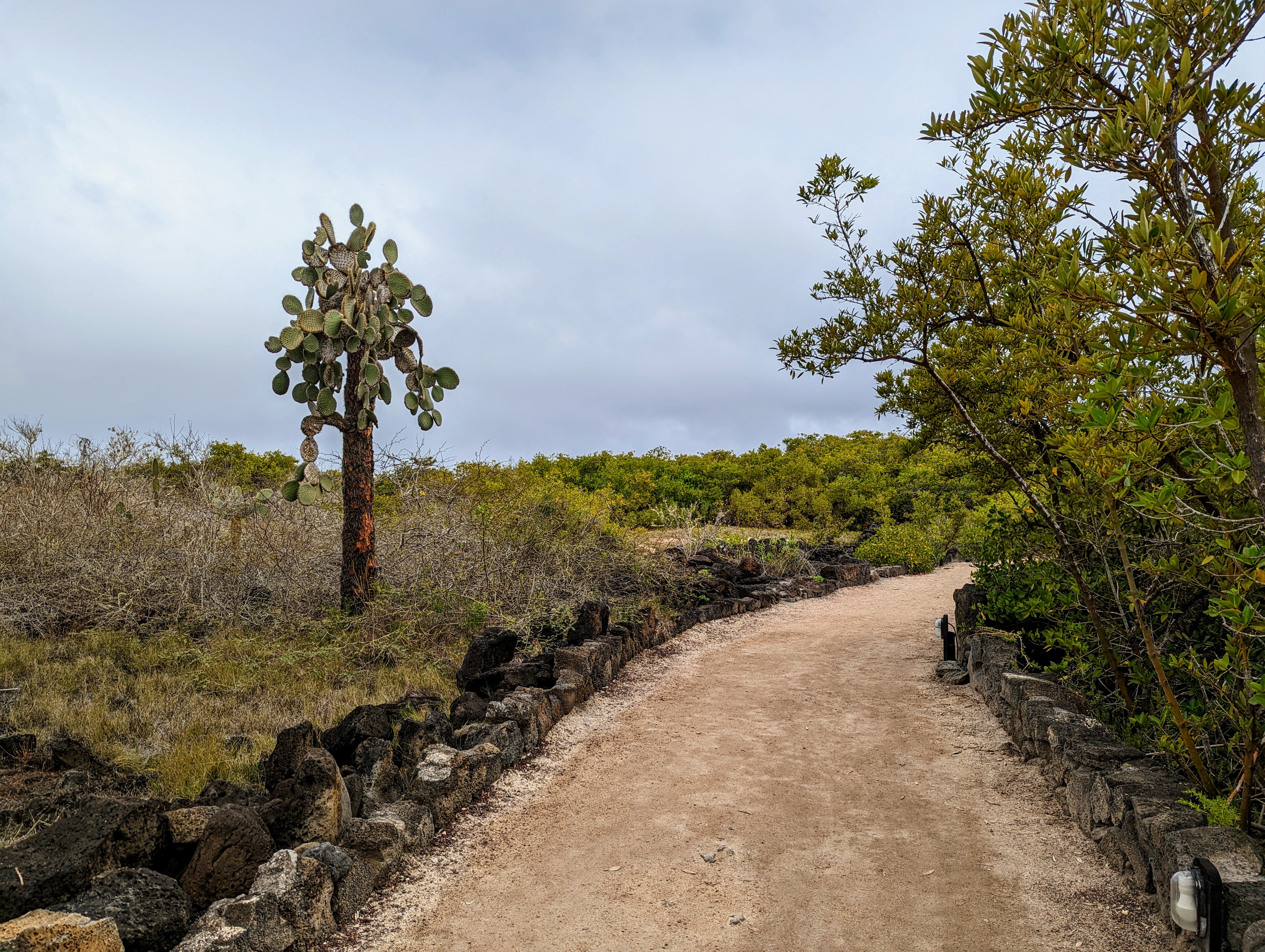
Walking the path to Las Grietas
The next day was our last day on Santa Cruz island. After a morning walk to the Charles Darwin Research Station and a great lunch at 1835 coffee lab, we headed to the pier to take our afternoon “ferry” to San Cristóbal island.
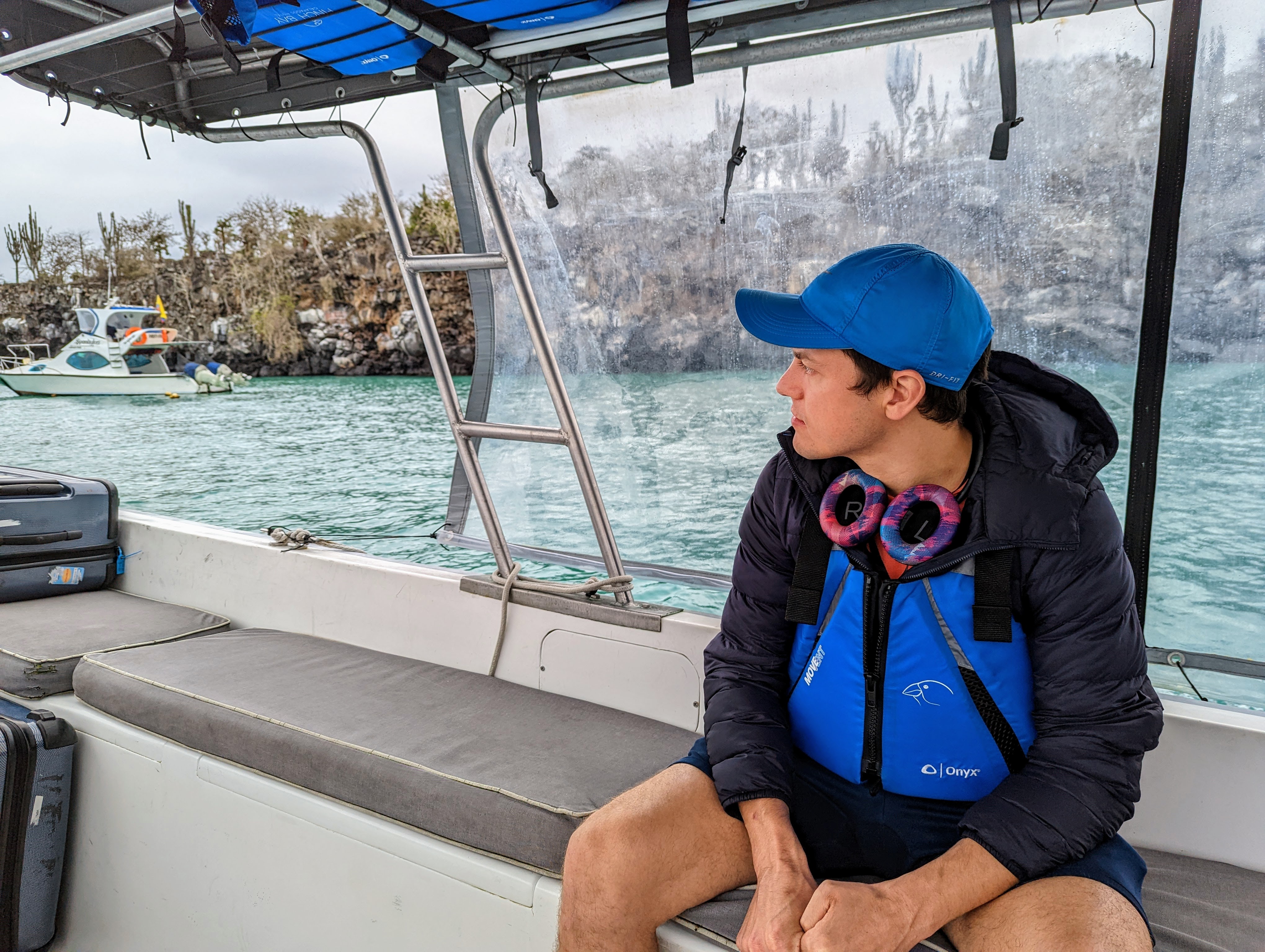
Taking the small Finch Bay boat over to the ferry dock
The ferry is really just a larger speedboat, seating about 40 people. The two hour ride from Santa Cruz to San Cristóbal can be rough. Thankfully our crossing was relatively calm but I still felt ill, seated near the front of the boat, without any windows to provide a view of the horizon, and a stifling life vest around my neck. So I moved to the back and squeezed myself into a gap between two sleeping backpackers so I could feel the breeze and keep an eye firmly on solid land.
